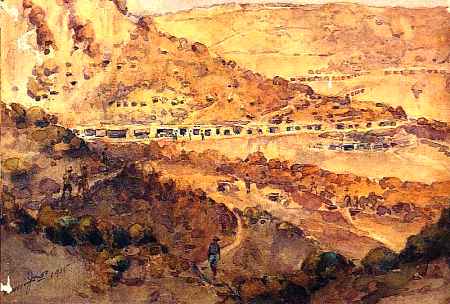Gallipoli Then and Now

This is a contributed item. Please direct your
feedback concerning the contents of this item to the author using
the e-mail link below. By all means let them know if you find it
interesting. They enjoy hearing from you! |
 |
| Anzac by H. Moore Jones
|
Contributed by mailto:snelders@glo.be and Marc
Colaes
Click on the link below to visit Jul's Gallipoli web site for even more
information on this topic:
http://user.glo.be/~snelders/
Click on the link below for The Turkey Traveller Tourist
Info:
http://www.turkeytraveller.org/
|
The Camera
Returns
If ghosts walk, they walk in Monash Valley and
Gully Ravine, and guard eternally the rocky escarpment of the
Gallipoli Peninsula.
Robert Rhodes James
Often for months at a time, nothing of any
consequence happens, lizards scuttle about the tombstones in the
sunshine and time goes by in an endless dream.
Alan Moorehead
Gallipoli is probably one of the few Great War battlefields that
has remained virtually unchanged over a period of more than 80
years. Many of the original trenches are still there and all the
important landmarks can be easily identified - as if time had stood
still.
What follows is just a sample of the many pictures we took during
our visits to the peninsula. For those interested in the 1915
campaign, we thought we might as well put the historical photographs
and the new ones side by side.
Jul Snelders |
Just click on thumbnail for expanded image.
Use
your browser's back button to return here.
Please stand by while
thumbnail images load...

71.15 Kb
800 x 527 |
ANZAC: The Sphinx and the Razor
Edge
This view is from a firing trench on Plugge's Plateau. Shortly
after the landing, Australian troops ran over the Razor Edge only 15
inches wide - from Plugge's to Russel's Top. At left, a steep slope
descends into Reserve Gully and at right into Rest gully, a branch
of Monash Valley. Both were among the few places that offered some
protection from Turkish fire. |

85.77 Kb
796 x 600 |

82.08 Kb
800 x 427 |
ANZAC: North
Beach
As seen from Walker's Ridge looking north. In the foreground are
the Outposts - firing positions that were not connected to the main
line. The building under the trees is where today new headstones for
the cemeteries are made for the War Graves Commission. In the far
distance is Suvla, with Nebrunesi Point at the end of the bay and
the salt lake in the middle. |

81.22 Kb
800 x 546 |

64.38 Kb
800 x 404 |
ANZAC: Gaba Tepe
Looking south from the original intended landing place for the
Australian Force to the strongly defended headland south of ANZAC
Cove. During the Campaign an unsuccessful raid was organized to
capture it. In the banks near the beach there is still evidence of
holes dug by the attackers to protect themselves from machine
gunfire. |

67.11 Kb
800 x 529 |

63.74 Kb
464 x 600 |
ANZAC: The south
flank
There are no original photographs of some portions of the ANZAC
line. The drawing looking north at ANZAC from the Turkish lines was
made by C.E.W. Bean in 1919 and published in his 'Gallipoli
Mission'. |

70.91 Kb
800 x 477 |

77.75 Kb
800 x 353 |
HELLES: Gully
Ravine
This entrance is to one of the main approaches to the front.
Notice the concrete well drilled by the Royal Engineers during the
campaign and still operational today. In the original photograph,
horses are being watered. |

73.23 Kb
800 x 422 |

133.66 Kb
800 x 485 |
HELLES: V Beach
From the cliffs near Fort #1, looking at the Old Sedd el Bahr
Fort. In the new picture, both the place where the River
Clyde was grounded on the beach, and the low bank under which
the survivors of the landing hid for the rest of the day can be
clearly seen. The cemetery contains the graves of the Dublins and
the Munsters. |

95.86 Kb
800 x 551 |

74.95 Kb
800 x 539 |
HELLES: W Beach
Looking west within the old picture - troops shortly after the
capture of the beach, which was to become known as Lancashire
Landing. |

71.42 Kb
800 x 541 |

78.74 Kb
805 x 419 |
HELLES: W Beach
Looking east later in the campaign. In the new picture the
remains of one of the piers. |

56.13 Kb
828 x 364 |

76.63 Kb
800 x 487 |
SUVLA:: West Beach
Harbour
Soon after the August landings by the British, the shore around
Suvla bay became one big army dump used to supply the troops further
inland. |

53.81 Kb
800 x 487
|
|
















